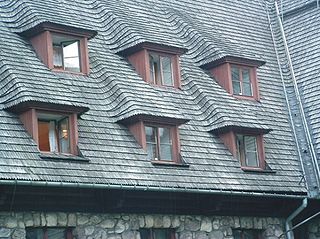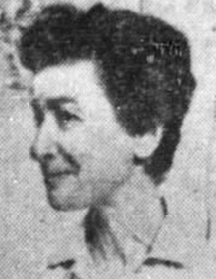
Redcedar bolts are relatively small (1 foot x 1 foot x 1 foot is common) cubes of Western Redcedar which are later processed into redcedar roof shingles. [1] [2]

Redcedar bolts are relatively small (1 foot x 1 foot x 1 foot is common) cubes of Western Redcedar which are later processed into redcedar roof shingles. [1] [2]
The United States Government Publishing Office is an agency of the legislative branch of the United States Federal government. The office produces and distributes information products and services for all three branches of the Federal Government, including U.S. passports for the Department of State as well as the official publications of the Supreme Court, the Congress, the Executive Office of the President, executive departments, and independent agencies.
The American School, also known as the National System, represents three different yet related constructs in politics, policy and philosophy. The policy existed from the 1790s to the 1970s, waxing and waning in actual degrees and details of implementation. Historian Michael Lind describes it as a coherent applied economic philosophy with logical and conceptual relationships with other economic ideas.
On March 5, 2002, U.S. President George W. Bush placed tariffs on imported steel. The tariffs took effect March 20 and were lifted by Bush on December 4, 2003. Research shows that the tariffs were a net positive, reviving many previously shuttered steel factories.

Juniperus virginiana, also known as eastern redcedar, red cedar, Virginian juniper, eastern juniper, red juniper, and other local names, is a species of juniper native to eastern North America from southeastern Canada to the Gulf of Mexico and east of the Great Plains. Further west it is replaced by the related Juniperus scopulorum and to the southwest by Juniperus ashei.

Thuja plicata is a large evergreen coniferous tree in the family Cupressaceae, native to the Pacific Northwest of North America. Its common name is western redcedar in the U.S. or western red cedar in the UK, and it is also called pacific red cedar, giant arborvitae, western arborvitae, just cedar, giant cedar, or shinglewood. It is not a true cedar of the genus Cedrus. T. plicata is the largest species in the genus Thuja, growing up to 70 metres (230 ft) tall and 7 metres (23 ft) in diameter. It mostly grows in areas that experience a mild climate with plentiful rainfall, although it is sometimes present in drier areas on sites where water is available year-round, such as wet valley bottoms and mountain streamsides. The species is shade-tolerant and able to establish in forest understories, and is thus considered a climax species. It is a very long-lived tree, with some specimens reaching ages of well over 1,000 years.

William Lyne Wilson was an American politician and lawyer from West Virginia. A Bourbon Democrat, he was elected to the United States Congress in 1882 and served six terms of office, ending in 1895.

The United States Senate Committee on Finance is a standing committee of the United States Senate. The Committee concerns itself with matters relating to taxation and other revenue measures generally, and those relating to the insular possessions; bonded debt of the United States; customs, collection districts, and ports of entry and delivery; deposit of public moneys; general revenue sharing; health programs under the Social Security Act and health programs financed by a specific tax or trust fund; national social security; reciprocal trade agreements; tariff and import quotas, and related matters thereto; and the transportation of dutiable goods. It is considered to be one of the most powerful committees in Congress.

The Civil Aeronautics Board (CAB) was an agency of the federal government of the United States, formed in 1938 and abolished in 1985, that regulated aviation services including scheduled passenger airline service and provided air accident investigation. The agency headquarters were in Washington, D.C.

The United States International Trade Commission is an agency of the United States federal government that advises the legislative and executive branches on matters of trade. It is an independent, bipartisan entity that analyzes trade issues such as tariffs and competitiveness and publishes reports. As a quasi-judicial entity, the USITC investigates the impact of imports on U.S. industries, and directs actions against unfair trade practices, such as subsidies; dumping; and intellectual property infringement, including copyright infringement.

Independence Avenue is a major east-west street in the southwest and southeast quadrants of the city of Washington, D.C., in the United States, running just south of the United States Capitol. Originally named South B Street, Independence Avenue SW was constructed between 1791 and 1823. Independence Avenue SE was constructed in pieces as residential development occurred east of the United States Capitol and east of the Anacostia River. Independence Avenue SW received its current name after Congress renamed the street in legislation approved on April 13, 1934. Independence Avenue SW originally had its western terminus at 14th Street SW, but was extended west to Ohio Drive SW between 1941 and 1942. The government of the District of Columbia renamed the portion of the road in the southeast quadrant of the city in 1950.

Roof shingles are a roof covering consisting of individual overlapping elements. These elements are typically flat, rectangular shapes laid in courses from the bottom edge of the roof up, with each successive course overlapping the joints below. Shingles are held by the roof rafters and are made of various materials such as wood, slate, flagstone, metal, plastic, and composite materials such as fibre cement and asphalt shingles. Ceramic roof tiles, which still dominate in Europe and some parts of Asia, are still usually called tiles. Roof shingles may deteriorate faster and need to repel more water than wall shingles. They are a very common roofing material in the United States.
Wood shingles are thin, tapered pieces of wood primarily used to cover roofs and walls of buildings to protect them from the weather. Historically shingles, also known as shakes, were split from straight grained, knot free bolts of wood. Today shingles are mostly made by being cut which distinguishes them from shakes, which are made by being split out of a bolt.
The US-Morocco Free Trade Agreement is a bilateral trade agreement between the United States and Morocco. The agreement was signed on June 15, 2004, followed by U.S. President George W. Bush's signing of the USMFTA Implementation Act on August 17, 2004. The United States House of Representatives ratified the pact on July 22, 2004 by a 323–99 vote. The United States Senate passed the bill by unanimous consent on July 21, 2004. The Morocco FTA came into effect on January 1, 2006.

The Trade Act of 1974 was passed to help industry in the United States become more competitive or phase workers into other industries or occupations.

The Emergency Tariff of 1921 of the United States was enacted on May 27, 1921. The Underwood Tariff, passed under President Woodrow Wilson, had Republican leaders in the United States Congress rush to create a temporary measure to ease the plight of farmers until a better solution could be put into place. With growing unrest in the American public, President Warren G. Harding and Congress passed the tariff.

Lincoln Dixon was an American lawyer and politician who served seven terms as a U.S. Representative from Indiana from 1905 to 1919.

Queen Anne style architecture was one of a number of popular Victorian architectural styles that emerged in the United States during the period from roughly 1880 to 1910. Popular there during this time, it followed the Second Empire and Stick styles and preceded the Richardsonian Romanesque and Shingle styles. Sub-movements of Queen Anne include the Eastlake movement.

A shingle weaver (US) or shingler (UK) is an employee of a wood products mill who engages in the creation of wooden roofing shingles or the closely related product known as "shakes." In the Pacific Northwest region of the United States, historically the leading producer of this product, such shingles are generally made of Western Red Cedar, an aromatic and disease-resistant wood indigenous to the area. The use of the term "weaver" for a shingle maker related to the way in which the workers fitted the shingles together in bundles but the meaning has extended to anyone who works in a shingle mill.

Penelope Hartland-Thunberg was an American economist and government official. She was a member of the United States Tariff Commission from 1965 to 1969. She received the Federal Woman's Award in 1965.